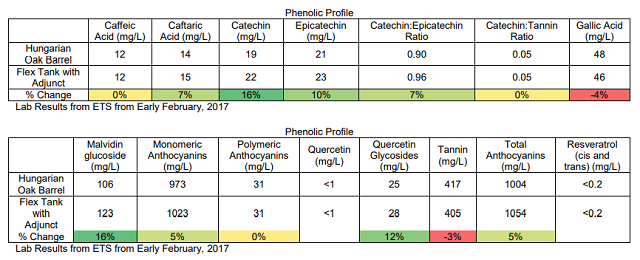The Effect of Oak Adjuncts vs Hungarian Oak Barrels in Chambourcin Aging (2016)
Bill and Tremain Hatch
Zephaniah Farm Winery
Summary
This study examines the impact of aging in new Hungarian oak barrels vs aging in flex tank with Hungarian oak Fans on the chemical and sensory profiles of Chambourcin. Chambourcin wine was split into these vessels with the corresponding treatment. Due to the differences between aging in barrel and flex tank, the wine in flex tank required higher additions of sulfur dioxide. Not many phenolic or chemical differences exist between wines, except the wine aged in flex tank showed higher levels of anythocyanins. Judges found the wines were found to be significantly different (p<0.05), but there were no major preferences for one treatment over the other. There was a slight trend for the flex tank wine to show more Oak Character and less Fruit Intensity. Overall, flex tanks show promise in wine aging, but more work needs to be done to address oxygen ingress and headspace issues, as well as fine-tuning the use of oak adjuncts.
Introduction
Despite their beneficial impacts on wine organoleptic quality, oak barrels are very expensive, difficult to clean, and can cause microbial and oxidative problems. Alternatives to aging wine in barrels which still impart the beneficial qualities of barrel aging, therefore, should be sought. The use of flex tanks for wine storage may act as an inexpensive means of aging wine, allowing for more mobility than aging in a stainless steel tank might afford while maintaining good cleanability. Using oak adjuncts may also mimic oak flavor that would be derived from barrels. However, flex tanks have issues with regard to oxygen ingress through the walls, and can have headspace issues as well. This study investigates the impact of aging in new Hungarian oak barrels vs aging in flex tank with Hungarian oak Fans on the chemical and sensory profiles of Chambourcin.
Results and Discussion
Due to the differences between aging in barrel and flex tank, the wine in flex tank required higher additions of sulfur dioxide. The relatively similar amounts of bound sulfur dioxide between treatments suggest that not many differences in oxidation existed between treatments, although this cannot be confirmed. Not many phenolic or chemical differences exist between wines, except the wine aged in flex tank showed higher levels of anythocyanins. This could be due to less adsorption of anthocyanins onto barrel char.


For the triangle test, of 29 people who answered, 16 people chose the correct wine (55%), indicating that the wines were significantly different (p<0.05). These wines were voted to have an average degree difference of 3.6 (out of 10), suggesting that the wines were not too different. In general, people who answered correctly preferred the barrel treatment to the flex tank (although this was a weak preference). No strong trends for these wines with the descriptors used in this study. There was a slight trend for the flex tank wine to show more Oak Character and less Fruit Intensity. Overall, flex tanks show promise in wine aging, but more work needs to be done to address oxygen ingress and headspace issues, as well as fine-tuning the use of oak adjuncts.


Methods
One block (1.3 acre Haverty Vineyard in Aldie, VA) of Chambourcin cropped at 4.7 tons was used for this trial. 6.2 tons of fruit was harvested on 9/27/2016. 50ppm sulfur dioxide was added at crush. A 5% saignee was taken immediately on the juice (juice analysis was taken before saignee). 2 gallons of Hungarian oak dust was added to the juice, along with 2 quarts of Hungarian oak chips. The fermentation was inoculated with BM45 the day of crush, rehydrated with Go Ferm. On 9/28, the fermentation was co-inoculated with Beta Co-Inoc. On October 10 the fermentation was pressed, and on October 16 the wines were barreled down with 75ppm sulfur dioxide either into 2016 Zemplin Hungarian Oak Barrels or into a Flex Tank with a Hungarian Oak Fan (the Flex Tank was a model with a lower Oxygen Transfer Rate). On November 22, 48ppm sulfur dioxide was added. All other fermentation and aging practices were identical between lots. Wine was taken for the Research Exchange on January 22.
This project was tasted on March 8. For the triangle test and preference analysis, anybody who did not answer the form were removed from consideration for both triangle, degree of difference, and preference. Additionally, anybody who answered the triangle test incorrectly were removed from consideration for degree of difference and preference. Additionally, any data points for preference which did not make sense (such as a person ranking a wine and its replicate at most and least preferred, when they correctly guessed the odd wine) were removed.
In order to balance the data set to perform statistical analysis for descriptive analysis, any judge who had not fully completed the descriptive analysis ratings were removed. In order to then make the amount of judges between groups equivalent, two judges from group 2 were removed. This resulted in a final data set of 3 groups, each with 9 judges (considered as replications within groups, and groups were considered as assessors). Data was analyzed using Panel Check V1.4.2. Because this is not a truly statistical set-up, any results which are found to be statistically significant (p<0.05) will be denoted as a “strong trend” or a “strong tendency,” as opposed to general trends or tendencies. The statistical significance here will ignore any other significant effects or interactions which may confound the results (such as a statistically significant interaction of Judge x Wine confounding a significant result from Wine alone). The descriptors used in this study were Fruit Intensity, Herbaceous/Green, Overall Aromatic Intensity, Oak Character, Reduced/Oxidized (on a scale from most reduced to most oxidized), and Body.
